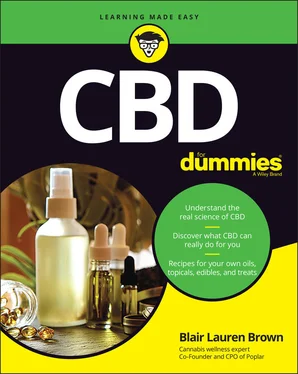Full-spectrum CBD: Full-spectrum CBD is the first outcome of any extraction. It carries all the parts of the plant leaves, the fiber, and the plant matter itself. The predominant theories are that full-spectrum is the most therapeutic of the extracts. Processing it to remove extra compounds results in the forms that follow.
Broad-spectrum CBD: As I write this, a lot of CBD products on the market have broad-spectrum oil as an active ingredient. A broad-spectrum extract is a result of removing one or more of the chemical compounds found in a full-spectrum extract (see the preceding section). A compound often targeted for removal is THC because, from a legal standpoint, CBD products are required to have no more than 0.3 percent THC.
Distillate: Distillation is a further step in processing and creating an extract without taste or aroma. Some call it a purification process. In a world with so many added chemicals, having a short ingredient list has become a selling point. Distillate is made to maintain a specific cannabinoid (such as THC) and nothing else, creating the desired potency without the effects of other components. ( Cannabinoids are the plant chemicals specific to cannabis and hemp plants; you can read more about them in Chapter 2.)
Isolate: Isolate is exactly that: an isolated chemical compound. In the case of CBD, an isolate is solely the cannabinoid CBD without any other terpenes, flavonoids, or cannabinoids. (I cover these substances in more detail in Chapter 2.) Isolate is your classic catch-22: It’s adored for its simplicity and equally unappreciated for its lack of complexity.
Other forms: Other forms of CBD aren’t directly derived from extraction but instead are yielded from further processing of an extracted form of CBD, full-spectrum, broad-spectrum, distillate and Isolate. For example, nanopartializing CBD is the process of making the chemical itself smaller. Water-soluble CBD is the result of suspending oil-based CBD into a water-based compound with an emulsion that keeps the two repelling agents, water and oil, from separating. These forms are popular because they’re believed to make the CBD easier for the body to take in, but the evidence on them is insufficient.
Identifying the Forms Resulting from Extraction
The incredible diversity of form is what makes the secondary market for CBD and other cannabis products so interesting. You can find some of the most common forms in the following sections.
 The CBD market continues to evolve. By the time this book publishes, some other form may well be all the rage.
The CBD market continues to evolve. By the time this book publishes, some other form may well be all the rage.
RSO stands for Rick Simpson Oil. Often considered a grandfather of the cannabis movement, Simpson was known for his forward-thinking, alternative approach to treating cancer with highly concentrated cannabis. This full-spectrum oil, also called Phoenix Tears, uses the whole plant except the fiber. It has a honey-like consistency and is very dark amber or brown. Though RSO is more common in the medicinal cannabis market with THC as a component, more and more versions with CBD flower extractions are starting to appear.
Consumption method varies by patient. The recommended approach involves small doses from a needleless syringe contraption. Some people prefer to take it under the tongue (sublingually), while others put a little dab on a piece of food.
Butane and alcohol extractions remain some of the most common with distillate, largely because of the consumption methods that follow. By extracting the CBD molecule along with other plant chemicals and plant matter, producers begin to form a refined version of the plant, distillate. It morphs from a sticky paste to an oil, depending on the distillation agent and the amount of time. Some prefer this method because it’s less expensive. As long as legality and price point dominate the market, it’s here to stay. For CBD in particular, distillation is a necessary step for removing THC to meet legal regulations.
Adding CBD distillate to a base of carrier oil or alcohol creates a host of ways to use it, from as an ingredient in a topical to as a topical in its own right to ingestible and more! For example, a popular use involves adding CBD distillate to carrier oils such as hemp seed oil, MCT oil, or the like for sublingual use or for vaporizing. Many people prefer inhalation via smoking as a dab, wax, resin, rosin, and more. I break down the aforementioned forms of consumption in Chapter 7.
Isolate is a pure CBD chemical extract with no other compounds from the plant or extraction method. Perfect extraction creates a clear, whitish, crystalline form that can become a white powder if crushed. Isolate that isn’t highly refined often has a damp, yellowish appearance, a reflection of its origin.
You can cleanly add isolate to a carrier oil, leaving no residual cannabis taste or smell. It’s mostly still used as an additive; however, people have been known to vaporize it exclusively for its effects.
Infusion is a common DIY method of extracting the beneficial compounds from plant matter’s chemicals and aromas. The process is worth exploring more if you have the time and interest.
Discovering the basics of CBD infusions
Most of cannabis’s plant matter is in lipid form, so the best way to create an infusion is with another oil-based material — butter, coconut oil, ghee (a clarified butter), or whatever. This combination results in bioavailability, or your body’s ability to take in the chemicals. Soaking the plant matter for an extended period imparts the valuable chemicals and aromas are into the carrier or base oil. Heat can also create this transfer as long as the heat isn’t so high that it compromises the plant’s integrity.
You can use CBD flower to supplement almost anything. It’s a great addition in butter for cookies, ghee for curries, oils for salad dressing, and so on. You do want to know the actual concentration of full-spectrum plant chemicals you’re infusing into your oil. All reputable providers — at the dispensary or online — will provide you with the certificate of analysis (COA), which outlines the concentration of cannabinoids and sometimes even terpenes in what you’re buying. The CBD concentration is written as a percentage; common numbers range from 5 percent to 25 percent, with 5 being low strength and 25 being the highest.
 You can also figure out concentrations yourself, as I explain in the following section.
You can also figure out concentrations yourself, as I explain in the following section.
Calculating concentrations like a champ
To calculate CBD concentrations, you have to convert the percentage of CBD in the flower to the number of milligrams in the volume of the flower. From there, you separate the volume into milligram servings based on your dosing requirements; that may be anywhere from five to a couple of hundred milligrams depending on your needs.
Don’t worry; you don’t need some fancy graphing calculator to figure this stuff out. The app on your phone is just fine. Here’s an example.
You have 1 gram of 15 percent CBD flower, and you want a 10-milligram dose per 1 tablespoon of oil. Convert 15 percent to a decimal (divide 15 by 100) to get 0.15.
Convert 1 gram to milligrams; 1 gram is 1,000 milligrams. Multiply 0.15 by 1,000 to get the amount of CBD per gram of flower.
Читать дальше

 The CBD market continues to evolve. By the time this book publishes, some other form may well be all the rage.
The CBD market continues to evolve. By the time this book publishes, some other form may well be all the rage. You can also figure out concentrations yourself, as I explain in the following section.
You can also figure out concentrations yourself, as I explain in the following section.










